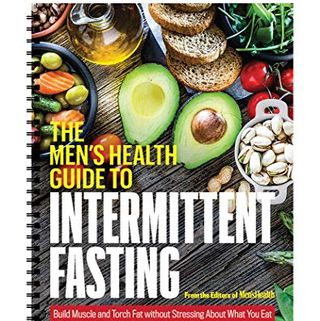
Fasting was easy for our ancient ancestors.
There were no all-night diners or frozen pizzas to tempt them. They had no choice but to ignore that gnawing emptiness in their stomachs until they happened upon a bush of ripe berries or got lucky with a spear.
Intermittent fasting, that is, purposely abstaining from eating for a certain number of hours or days, is much harder for modern humans who have access to food 24/7. (Insomnia Cookies delivers until 3 a.m.) But regular extended breaks from eating can be so beneficial to our welfare (not to mention our waistlines) that it’s worth the struggle.
To understand just how, it helps to realize what happens in our bodies when we eat like normal Americans do, which is to say, all day and too much of the wrong stuff. We eat a lot of protein and carbohydrates—think meat and potatoes (and chips, cookies, pasta, bread, juice, beer, etc.).

Men’s Health Guide to Intermittent Fasting
amazon.com
$24.95
BUY NOW
When we digest those macronutrients, our bodies respond by releasing the hormone insulin. Insulin’s job is to regulate our blood sugar by breaking down the glucose for energy and ushering it into our cells for use.
But if we eat throughout the day and night, our bodies never get a break from the constant release of insulin. Over time, the insulin becomes ineffective at dealing with high blood sugar, so the body pumps out more and more and eventually develops insulin resistance, the precursor to diabetes.
Intermittent eating—reducing our calorie-consuming window—slows the release of insulin and allows the body to seek out fat for energy. “Many studies suggest that intermittent fasting may be a healthier way to eat, be a more effective approach for weight loss, and even slightly boost your metabolism,” says Carolyn Williams, Ph.D., R.D., in The Men’s Health Guide to Intermittent Fasting.

VioletaStoimenova
Williams, who was skeptical of IF at first, became a fan shortly after trying the popular 16:8 IF plan, in which you fast for 16 hours (overnight) and consume all calories in only an 8-hour “eating window.” Williams found that IF kept her blood sugar levels more stable compared to when she ate many times during the day and night. She was surprised to find that IF was pretty painless; she never became ravenous.
How did she do it? Well, what you do eat during that feeding window turns out to be just as important as when you don’t eat.
Seven Tricks to Avoiding the Intermittent Fasting “Hangries”
For more tips and tricks to help work fasting into your life, grab a copy of The Men’s Health Guide to Intermittent Fasting.
Source: Read Full Article